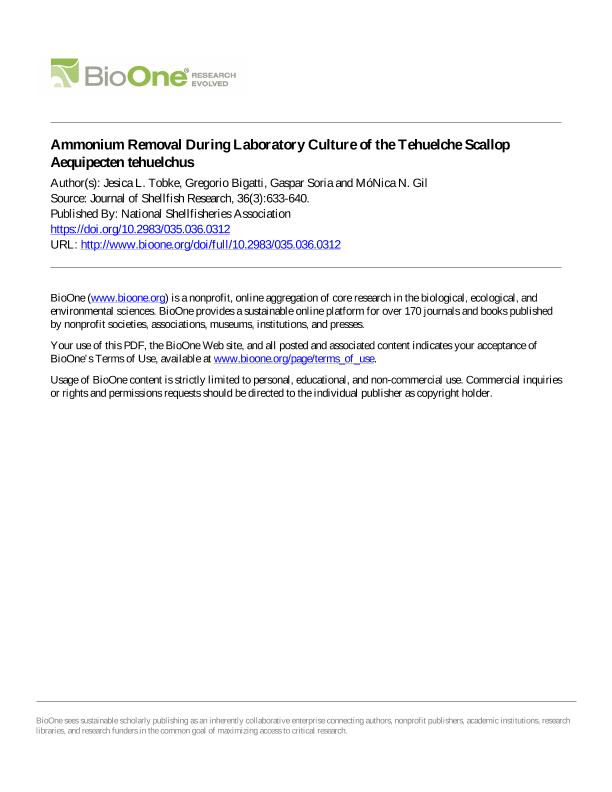Artículo
Ammonium removal during laboratory culture of the Tehuelche Scallop Aequipecten tehuelchus
Fecha de publicación:
12/2017
Editorial:
National Shellfisheries Association
Revista:
Journal Of Shellfish Research
ISSN:
0730-8000
e-ISSN:
1943-6319
Idioma:
Inglés
Tipo de recurso:
Artículo publicado
Clasificación temática:
Resumen
Laboratory-scale research involving marine bivalves maintained in recirculating or closed aquaria requires control of seawater quality parameters. Among them, the total dissolved ammonium nitrogen (TAN), NH 4 + + ammonia (NH 3 ) nitrogen, concentration is a critical parameter because of its potential toxicity, mainly in closed systems. This study assessed the efficacy of two macroalgal species collected in Golfo Nuevo (Patagonia, Argentina) in removing TAN from the seawater of experimental systems containing the Tehuelche scallop ( Aequipecten tehuelchus ). The use of the traditional nitrifying bacterial biofilter was also explored. Scallops were collected from the Gulf of San Jos e (Patagonia, Argentina) where they support an artisanal fishery of great socioeconomic importance. This resource is currently threatened by declining landings observed in the previous years, and experimental research is needed to explore the best conditions for ex situ cultivation. A 14 day-experiment was conducted in 3-L beakers containing an adult scallop with addition of a biofilter (treatment T1: containing Ulva spp.; T2: Undaria pinnatifida ; T3: bacterial biofilter; and T4: mechanical filtration before Ulva spp. addition). Negative controls (NC) (no scallop or biofiltration) and positive controls (PC) (without biofiltration) were also performed. The concentration of TAN was measured at the beginning of the experiment and every 48 h, and temporal patterns were described by regression models. Removal efficiency relative to PC was calculated on days 8 (Rd8%) and 14 (Rd14%). Ammonia concentration was estimated as a function of seawater temperature, pH, and salinity. In PC, TAN increased at a rate of 0.03 mg L – 1 h – 1 , reaching a final mean value of 9.85 mg L – 1 for total dissolved NH 4 + -N + NH 3 -N (TAN-N) (12.69 mg L – 1 TAN) and 0.15 mg L – 1 for NH 3 . In T1, TAN ranged from 0.02 to 0.22 mg L – 1 TAN-N during the first 10 days of the experiment (below those measured in PC, T2, and T3), and Rd8 and Rd14 were 98% and 84%, respectively. The highest TAN concentrations observed in the whole experiment were measured in T2, exceeding those in PC. In T3, TAN-N mean concentrations on days 8 and 14 were 1.45 mg L – 1 (Rd8 73%) and 0.45 (Rd14 95%), respectively. In T4, a linear increase of TAN was observed during the mechanical filtration period; after Ulva spp. addition, TAN decreased to levels as low as those measured in NC ( < 0.025 mg L – 1 TAN-N) until the end of the experiment (Rd14 100%). These results show that Tehuelche scallops may be relatively resistant to TAN and that NH 3 concentrations were higher than several safety standards. The seaweed Ulva spp. provided the most efficient biofilter between both tested seaweeds, and its usage would represent a good alternative for the traditional bacterial biofilter in small-scale aquaculture experiments, including long-term acclimation. This information is useful for conducting experimental assays of this overexploited artisanal scallop resource from the Patagonian coast.
Archivos asociados
Licencia
Identificadores
Colecciones
Articulos(CESIMAR)
Articulos de CENTRO PARA EL ESTUDIO DE SISTEMAS MARINOS
Articulos de CENTRO PARA EL ESTUDIO DE SISTEMAS MARINOS
Citación
Tobke, Jesica Lis; Bigatti, Gregorio; Soria, Rodrigo Gaspar; Gil, Monica Noemi; Ammonium removal during laboratory culture of the Tehuelche Scallop Aequipecten tehuelchus; National Shellfisheries Association; Journal Of Shellfish Research; 36; 3; 12-2017; 633-640
Compartir
Altmétricas




